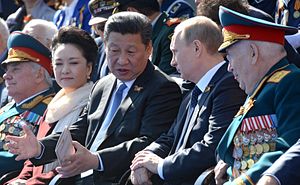China and Russia are purportedly considering holding their joint annual naval exercise, Joint-Sea 2016, in the South China Sea this September, China Military Online reports.
At a press conference on June 30, Chinese Defense Ministry spokesperson Wu Qian said that both countries are currently reviewing the details of the upcoming drill without providing additional information.
However, given that the People’s Liberation Army Navy (PLAN) North and East Sea Fleets hosted previous Sino-Russian naval drills, it appears likely that this year’s iteration of the Joint-Sea exercise will be hosted by the Nanhai [South Sea] Fleet, the PLAN fleet responsible for the South China Sea.
This is at least what China’s state-owned media is speculating:
In previous exercises when China served as the host, the directing fleets were the North China Sea Fleet and the East China Sea Fleet respectively. Therefore, this time it is very likely that the South China Sea Fleet will take its turn as the main power, and the location might be near the South China Sea as well (…).
China and Russia have conducted six joint naval exercises since 2005. China first served as the host for the annual Joint-Sea drill in 2012. In 2015, Beijing and Moscow “held naval and amphibious assault exercises in the Sea of Japan, a smaller naval drill in the Mediterranean, among a number of other bilateral military exchanges. Both countries have also participated in trilateral, and multilateral exercises, for example, under the umbrella of the Shanghai Cooperation Organization (SCO),” I reported in April.
The recent speculations over where the largest Sino-Russian naval drill will be held comes at a time of increased tensions in the South China Sea, particularly given that an international court is set to rule in the Philippines’ arbitration against Chinese maritime claims in the South China Sea in a few days.
The PLAN stepped up its presence in the South China Sea over the last few months. For example, China has kicked off a unilateral naval drill on July 5 in the disputed waters. It also held an exercise involving the Paracel and Spratly Islands in May.
As I reported elsewhere (See: “China and Russia to Increase Number of Military Exercises in 2016”), Russian Defense Minister Sergey Shoigu and his Chinese counterpart, State Councilor and Defense Minister Gen Chang Wanquan, vowed in April to increase the number of joint military exercises in 2016.
Given that China and Russia do not have a formal military alliance, the interaction between the two navies will be limited and cannot be compared to similar exercises held by NATO, particularly when it comes to practicing complex integrated military operations. The major rationale behind the joint drills will be political rather than practical and is meant to emphasize the burgeoning security partnership between the two countries.

































